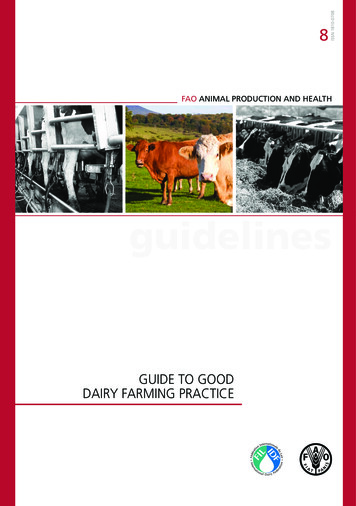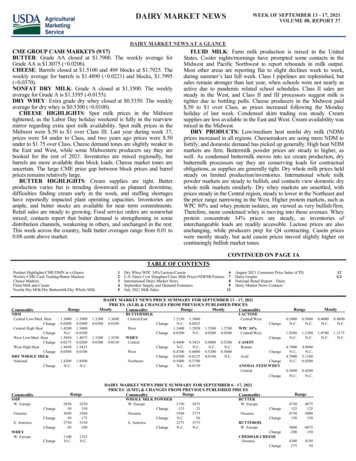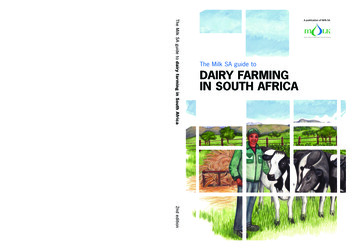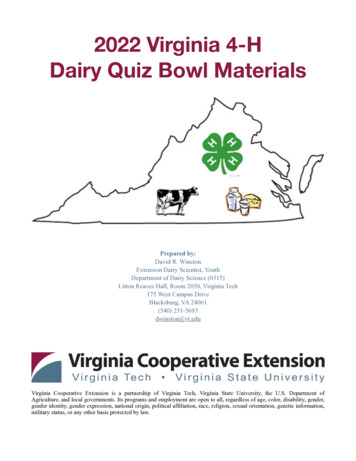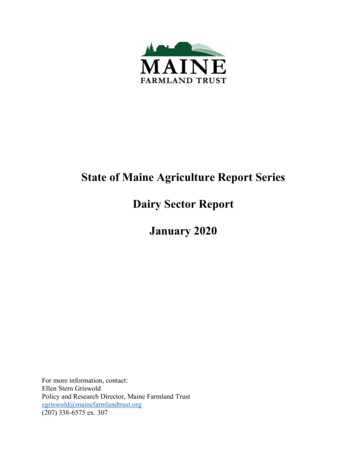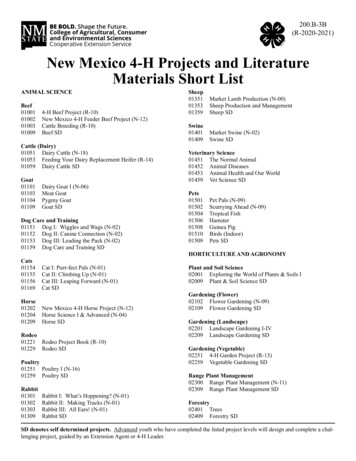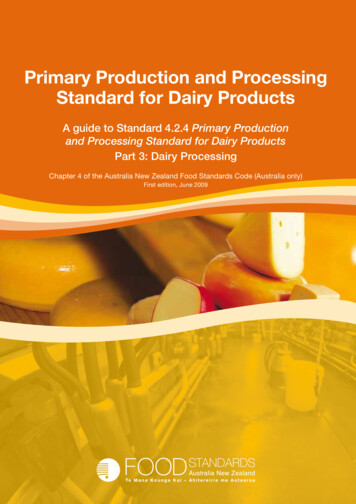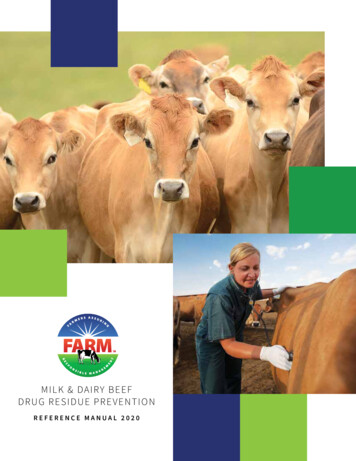
Transcription
DAIRY MARKET NEWSWEEK OF JUNE 13 - 17 2022VOLUME 89, REPORT 24DAIRY MARKET NEWS AT A GLANCECME GROUP CASH MARKETS (6/17)BUTTER: Grade AA closed at 2.9400. The weekly average forGrade AA is 2.9560 (-0.0230).CHEESE: Barrels closed at 2.1575 and 40# blocks at 2.1450. Theweekly average for barrels is 2.1795 (-0.0790) and blocks, 2.1705(-0.1025).NONFAT DRY MILK: Grade A closed at 1.8000. The weeklyaverage for Grade A is 1.8165 (-0.0555).DRY WHEY: Extra grade dry whey closed at 0.5075. The weeklyaverage for dry whey is 0.5080 (-0.0290).CHEESE HIGHLIGHTS: Milk is readily available for cheeseproducers throughout the regions. Spot milk prices in the Midwestranged from 5 to 1 under Class III. Despite the extra milk,cheesemakers in all regions are reporting regular concerns regardingshorthandedness and supply chain snags at the production level.Demand notes are mixed, but Western contacts relay some consumerhesitance at current upward price movements. Export demand remainshealthy, based on competitive global cheese values. Block and barrelprices on the CME are under some downward pressure. Cheese stocksare noted as balanced to slowly building.BUTTER HIGHLIGHTS: Summer temperatures are starting toaffect cream availability at the butter churn. Additionally, increased icecream production has thinned cream availability, particularly in theMidwest and East. Western cream stores remain widely available forprocessing. Butter plant managers continue to prepare for fall demandneeds, as they churn and/or micro-fix at somewhat active levels,although staffing shortages are being regularly reported throughout thenation. Seasonally, butter demand is currently somewhat quiet,although it continues to meet producers’ expectations. Butter markettones remain quite firm, as prices continue to hover just under the 3benchmark.FLUID MILK: Milk production is somewhat mixed across thecountry, but output is generally trending level to lower. Hottemperatures across southern states, from coast to coast, are impactingcow comfort and contributing to declining farm level milk output.Production is flat in the Pacific Northwest and varies in the Northeast.Bottling sales are stable to seasonally lower. Class III demand issteadily strong, boosted by robust cheese production across thecountry. Contacts say condensed skim is available in Western andCentral states but spot loads are harder to come by in the East. Tightercream supplies in the Central and East are reflected in highermultiples. Cream is available in the West, and some loads are movinginto other regions. Cream demand is present, but some butter and icecream production schedules have been reduced in response to staffingissues and/or transportation delays. F.O.B. cream multiples for allclasses are 1.32-1.43 in the East, 1.26-1.35 in the Midwest, and 1.051.31 in the West.DRY PRODUCTS: Low/medium heat nonfat dry milk (NDM)prices are mostly unchanged. Domestic trading is slower in the Centraland East regions on tighter supplies. Spot sales are more active in theWest. High heat NDM prices are steady, and inventories are limitedacross regions. Dry buttermilk prices pushed higher in all regions. Spotavailability is tight. Reduced butter output is hampering dry buttermilkproduction. Dry whole milk prices are unchanged. Production issporadic, and spot offers from some manufacturers have been muted.Dry whey prices are mostly lower. Domestic demand is mixed, andinventories are steady to growing. Whey protein concentrate (WPC)34% prices slipped lower. Inventory levels and demand are mixed,depending on WPC 34% specification. The lactose price range isunchanged. Contract negotiations are ongoing for Q3, with pricesreportedly near or slightly higher than Q2 prices. Production is active.Prices for both acid and rennet casein are steady this week.ORGANIC DAIRY MARKET NEWS: Total organic dairy retailads declined 7 percent. The organic dairy retail survey resultscomprised milk, cream cheese, and yogurt only, as retailers choose toforego weekly specials for other organic dairy products that aretypically surveyed. The percentage of ads for organic milk, creamcheese, and yogurt are 78, 3, and 19, respectively. Organic milk, themost advertised dairy commodity, saw retail store ads increase 2percent. Organic milk in gallon containers had the largest volume oforganic dairy retail store ads, up 100 percent. The national weightedaverage advertised price, 4.95, when compared to the conventionalgallon milk national weighted average advertised price, 3.33, affordsa 1.62 organic premium. Organic yogurt posted the largest week-over-week ad adjustment, advancing 52 percent in ads compared to theprevious retail survey. Regular 32-ounce organic yogurt had the largestvolume of ads, up 219 percent. The price per container, 4.05, resultedfrom the 58 cents drop in the weighted average retail price. Greekyogurt 32-ounce followed closely in ad volume, but ads declined 35percent while the weighted average retail price increased 30 cents to 5.99 per container.CONTINUED ON PAGE 1ATABLE OF CONTENTSProduct Highlights/CME/DMN at a GlanceWeekly CME Cash Trading/Butter MarketsCheese MarketsFluid Milk and CreamNonfat Dry Milk/Dry Buttermilk/Dry Whole MilkCommodityNDMCentral Low/Med. HeatChangeCentral High HeatChangeWest Low/Med. HeatChangeWest High HeatChangeDRY WHOLE 0N.C.2.1000N.C.2.4500N.C.12345Dry Whey/WPC 34%/Lactose/Casein6U.S Dairy Cow Slaughter/Class Milk Prices/NDPSR/Futures 7Organic Dairy Market News8May Consumer Price Index (CPI)9May Producer Price Index (PPI)10Supply and Demand Estimates11April Estimated SalesDairy GraphsNational Retail Report - DairyDairy Market News ContactsDAIRY MARKET NEWS PRICE SUMMARY FOR JUNE 13 - 17, 2022PRICES ( /LB) & CHANGES FROM PREVIOUS PUBLISHED ast1.9350 2.0225Change 0.0150 0.0200West1.8700 2.0050 1.9200 1.9500Change 0.0100 0.0050 0.0100N.C.WHEYCentral0.5000 0.6400 0.5400 0.6000Change 0.0150 -0.0050 -0.0100N.C.West0.4625 0.6800 0.5500 0.6300Change -0.0350 -0.0175 0.0025 -0.0075Northeast0.5500 0.6650ChangeN.C. .1.5000 2.0000Change -0.1000 .3200N.C.Mostly0.5700N.C.ChangeWPC L FEED 000N.C.
WEEK OF JUNE 13 - 17, 2022DAIRY MARKET NEWSDAIRY MARKET NEWS AT A GLANCECONTINUED FROM PAGE 1NATIONAL RETAIL REPORT: Total dairy advertisements werelower during week 24, as conventional ad numbers declined by 21percent and total organic ad numbers were seven percent lower.Conventional ice cream, in 48 to 64 ounce containers, was the mostadvertised item, as ad numbers grew by 18 percent week to week.Cream cheese and half-gallon milk ads, on the conventional aisle, bothincreased weekly, but they were rarities on a week when a majority ofdairy ads decreased.MAY CONSUMER PRICE INDEX (BLS): The May CPI for allfoods is 302.0, up 10.1 percent from 2021. The dairy products index is257.7, up 11.8 percent from a year ago. The following are the May, yearto year percentage changes for selected products: fresh whole milk, 16.9; cheese, 8.7; and butter, 15.9.MAY PRODUCER PRICE INDEX (BLS): The May PPI for allfood is 252.2, up 12.6 percent from 2021. The dairy products index is251.0, up 19.4 percent from a year ago. The following are the May, yearto year percentage changes for selected products: fresh whole milk, 24.4; cheese, 17.2; and butter, 47.4.JUNE SUPPLY AND DEMAND ESTIMATES (USDA,WAOB): Milk production for 2022 is forecast lower than last month onslower growth in milk-per-cow than previously expected. Milk per cowis also reduced slightly for 2023, resulting in lower forecast milkproduction. For 2022, commercial exports on a fat basis are unchangedfrom last month, but skim-solids exports are raised on stronger exportsof whey and lactose. For 2023, exports are raised on a fat basis due tostronger expected cheese exports but reduced on a skim-solids basis dueto weaker expected sales of skim milk powder.APRIL 2022 MILK SALES (NASS): Total Fluid Products Sales3.6 billion pounds of packaged fluid milk products were shipped bymilk handlers in April 2022. This was 2.1 percent lower than a yearearlier. Estimated sales of total conventional fluid milk productsdecreased 2.0 percent from April 2021 and estimated sales of totalorganic fluid milk products decreased 3.4 percent from a year earlier.NOTICE: USDA Announces Partnership with Port OfHouston And Expansion Of Partnership With NorthwestSeaport Alliance to Ease Port Congestion and RestoreDisrupted Shipping Services to U.S. Grown -and-expansion-partnership-northwestseaportNOTICE: USDA Reopens the Comment Period for ProposedRule to Reapportion Membership for the National DairyPromotion and Research p-national-dairypromotion-1A-VOLUME 89, REPORT 24
DAIRY MARKET NEWS, JUNE 13 - 17, 2022COMMODITYMONDAYTUESDAYJUN 13JUN 14CHEESEBARRELS40 POUND BLOCKSNONFAT DRY MILKGRADE ABUTTERGRADE AADRY WHEYEXTRA GRADE-2WEDNESDAY THURSDAYJUN 15JUN 16FRIDAYJUN 17::VOLUME 89, REPORT 24WEEKLY::WEEKLYCHANGEAVERAGE 2.2200(-0.0225) 2.1750(-0.0450) 2.2100( 0.0350) 2.1350(-0.0750) 2.1575( 0.0225)::::(-0.0850):::: 2.1795(-0.0790) 2.2175(-0.0375) 2.1850(-0.0325) 2.2250( 0.0400) 2.0800(-0.1450) 2.1450( 0.0650)::::(-0.1100):::: 2.1705(-0.1025) 1.8550(N.C.) 1.8200(-0.0350) 1.8175(-0.0025) 1.7900(-0.0275) 1.8000( 0.0100)::::(-0.0550):::: 1.8165(-0.0555) 2.9300(-0.0450) 2.9800( 0.0500) 2.9700(-0.0100) 2.9600(-0.0100) 2.9400(-0.0200)::::(-0.0350):::: 2.9560(-0.0230) 0.5150(-0.0275) 0.5150(N.C.) 0.5100(-0.0050) 0.4925(-0.0175) 0.5075( 0.0150)::::(-0.0350):::: 0.5080(-0.0290)Prices shown are in U.S. dollars per lb. in carlot quantities. Carlot unit weights: CHEESE, 40,000-44,000 lbs.; NONFAT DRY MILK, 41,000-45,000 lbs.; BUTTER, 40,000-43,000 lbs.;DRYWHEY, 41,000-45,000 lbs. Weekly Change is the sum of Daily Price Changes. Weekly Average is the simple average of the Daily Cash Close prices for the calendar week. Weekly AverageChange is the difference between current and previous Weekly Average. Computed by Dairy Market News for informational purposes. This data is available on the Internet atWWW.AMS.USDA.GOV/MARKET-NEWS/DAIRYNOTICE: Five days of trading information can be found at ta.htmlBUTTER MARKETSNORTHEASTWESTEastern cream availability is waning as farm level milk productiondiminishes in the summer heat. Contacts say regional butter productionschedules are still reduced, guided by both typical seasonal patterns andcurrently weaker domestic sales. Inventories are lower. Market participantopinions range from optimistic to pessimistic regarding whether butterstocks will be capable of satisfying fall demand. Food service orders arereportedly declining in some areas, which some view as a trend reversal forthe summer vacation season. As costs mount for fuel and consumer goods,some would-be restaurant patrons are choosing to cook and eat at homeinstead. Retail sales are also trending lower. Some grocery customers areopting to try lower priced butter alternatives at this time. Through Tuesday,spot butter prices have vacillated on the CME this week. Eastern bulkbutter overages are unchanged from last week and range from 10.0 to 15.0cents above the CME market value.Cream is getting a little tighter but is still readily available for Westernbutter making operations. Some spot cream is even flowing to other areaswith lower local supplies, although driver shortages and costly fuel andfreight expenses hinder further movement in some cases. Butter productionis steady in the West. Some producers are working to grow inventoriesahead of fall demand. As prices trend upward and U.S. butter loses itscompetitive edge on global markets, some stakeholders indicate exportdemand is softer month to month as well as year over year. Domesticconsumer butter usage is also declining. Retail sales are down whencompared to last year. Some grocery store chains are featuring butterpromotions in weekly circulars in an attempt to encourage customerpurchases. Food service orders are sliding downward. Some eateries areoperating during reduced hours, or even days of the week, due to high inputcosts, lower consumer demand, and persistent staffing shortages. Westernbulk butter overages are unchanged this week and range from 5.0 to 15.0cents above the CME market value.Prices for: Eastern U.S., All First Sales, F.O.B., Grade AA, Conventional,and Edible ButterBulk Basis Pricing - 80% Butterfat /LB: 0.1000 - 0.1500CENTRALButter producers say cream is somewhat tight in the region, but there arestill some available loads from the West. The issue there is finding haulerswho are available to transport cream loads from the mountain states areainto the upper Midwest. Again, though, continued reports of short staffingat the butter plant level is keeping butter production restrained. Butter plantcontacts say the timing could be worse for limited staffing, as butterdemand is in a seasonal lull. Regardless, current employees are stayingbusy, as plant managers prepare for late summer/early fall demand needs.Plants are mixed in production methods between churning and microfixing. Expectations are that micro-fixing rates will grow by the end of thismonth. Butter market tones are firm.Prices for: Central U.S., All First Sales, F.O.B., Grade AA, Conventional,and Edible ButterBulk Basis Pricing - 80% Butterfat /LB: 0.0600 - 0.1500Prices for: Western U.S., All First Sales, F.O.B., Grade AA, Conventional,and Edible ButterBulk Basis Pricing - 80% Butterfat /LB: 0.0500 - 0.1500
DAIRY MARKET NEWS, JUNE 13 - 17, 2022-3-VOLUME 89, REPORT 24CHEESE MARKETSNORTHEASTWHOLESALE SELLING PRICES: DELIVEREDDOLLARS PER POUND(MIXED LOTS (1000-5000 POUNDS))Milk is available for Northeastern Class III operations. Production isactive in the region, although some cheesemaking facilities are operating at a reduced capacity due to supply chain issues and/or staffingshortages. Cheese inventories are sturdy. Some contacts say there isequilibrium between supply and demand for now, however, which ishelping to prevent abundant cheese stocks from becoming burdensome. On international markets, U.S. cheese is priced competitively.Export demand is hearty. Retail cheese sales are flat to weaker. Asinflationary pressures stretch budgets thin, some contacts speculatecustomers could be eliminating cheese from pared down groceryshopping lists over other staple items. Food service demand is steadyto, in some areas, a little softer. Block and barrel prices have bothslipped lower through Tuesday on the CME this week.WHOLESALE SELLING PRICES: DELIVEREDDOLLARS PER POUND(MIXED LOTS (1000-5000 POUNDS))Cheddar 40 pound BlockMuensterProcess American 5 pound SlicedSwiss 10-14 pound 6.2975Cheddar 10 pound CutsCheddar 40 pound BlockMonterey Jack 10 poundsProcess American 5 pound LoafSwiss 6-9 pound CutsFOREIGNIndustry contacts report European cheese production has remainedat high levels as manufacturers try to catch up on orders and shipments. Retail orders are solid. Shoppers are seeking out store salesand other deals to ease the effects of higher prices at the checkout.Contacts say wholesale buyers are expecting travel, and the corresponding sales of cheese into restaurants and tourist destinations, toincrease as well. However, export sales are not as easy. The highfreight costs and cheese prices have dissuaded some internationalcheese buyers. European cheese stocks are still tight, but availabilityof some varieties is improving. As milk intakes decline seasonally,manufacturers are cautious to maintain the delicate balance betweensupply and demand for cheese.WHOLESALE SELLING PRICES: FOB DISTRIBUTORS DOCKDOLLARS PER POUND (1000 - 5000 POUNDS, MIXED LOTS)MIDWESTMidwestern cheese producers are reporting a surge of milk availability in the region. Milk growth, off the farm, is not increasing, but theamount of manufacturing plants down for a variety of reasons haspushed extra milk into the continually running plants. Spot milk prices have been reported as low as 5 under Class III at report time.Cheese orders are meeting seasonal expectations from cheesemakercontacts. Cheddar and Italian style cheesemakers say orders are seasonally quieter, but contract orders are keeping inventories moving.Curd producers, though, are in the midst of their busy season. Theyrelay if an order gets canceled, the next buyer is eager to accept anextra load. Cheese market tones have settled in recent weeks.VARIETYBlueGorgonzolaParmesanRomanoSardo Romano (Argentina)Reggianito (Argentina)JarlsbergSwissSwiss 3.4900-3.6075WESTCheese sales are trending lower in the retail sector. Food service orders are also faltering. Amid high input costs, ongoing labor poolissues, and consumer resistance to upward price pressures, some eateries are offering streamlined menu options and/or serving duringabbreviated hours of operation. Export cheese demand, on the otherhand, remains robust. Inquiries are steady from international customers. Some contacts report buyers in Asia are already looking to lockdown cheese orders into Q1 of 2023. Western cheese production isbusy. Milk is available for cheesemaking. Market participants reportthat Class III milk intakes are at maximum capacity for some plants.Other plants are running under capacity due to production/packagingsupply delays and staffing shortages. Regional cheese inventories aregenerally stable to growing. Contacts say both barrel and block spotsupplies are available at this time.::::::::::::NEW 6.0650*3.7775-5.9325*-0-0-04.0100-4.3350-0-* Price change.WISCONSIN WHOLESALE SELLING PRICES: DELIVEREDDOLLARS PER POUND(MIXED LOTS (1000-5000 POUNDS))Blue 5 poundsBrick 5 poundsCheddar 40 pound BlockMonterey Jack 10 poundsMozzarella 5-6 poundsMuenster 5 poundsProcess American 5 pound LoafSwiss 6-9 pound 2.51502.7825-4.2125COLD STORAGEWEEKLY COLD STORAGE HOLDINGS - SELECTED STORAGE CENTERSIN THOUSAND POUNDS - INCLUDING GOVERNMENT STOCKS06/13/202206/01/2022CHANGE% 4330-1580-2
DAIRY MARKET NEWS, JUNE 13- 17, 2022-4-VOLUME 89, REPORT 24FLUID MILK AND CREAMEASTMilk flows are a little mixed throughout the Northeast. Bottlingdemand is level week to week. Cheesemaking remains active in theregion, keeping Class III orders elevated. Mid-Atlantic milkproduction off farms is flat to down. Class I sales are lower. Someschool districts/community programs are providing meals for studentsduring the summer break. Summer temperatures are climbing in theSoutheastern states. Farm level milk production is declining in theheat. Recent reports suggest hot, dry weather is stressing corn cropsand pastureland in some areas. Bottling sales are trending down.Some balancing operations are bringing in supplemental milk loadsfrom other regions. Milk output is lower in Florida. Class I sales areunchanged from last week. Cream availability is tightening, andmultiples have ticked higher. Butter output is down. Cream demand ispresent from other cream-based manufacturers, but some, includingice cream makers, are running reduced production schedules due tolabor pool issues and supply chain outages/delays. Condensed skimspot availability is drying up, according to some contacts.Transportation challenges, particularly in the Northeast, continue tofurther burden access to condensed skim by hindering its movement.Northeastern U.S., F.O.B. Condensed SkimPrice Range - Class II; /LB Solids:Price Range - Class III; /LB Solids:Northeastern U.S., F.O.B. CreamMultiples Range - All Classes:Price Range - Class II; /LB Butterfat:1.87 - 1.921.80 - 1.851.3200 - 1.43003.9323 - 4.2600MIDWESTMilk output is still mostly steady in the region, despite some slightdeclines being reported. Storms in the upper Midwest are not the onlyweather conditions dairy farmers are facing. Some days with morninglows in the 40s are being followed by days with afternoons in the 90s.This being said, more of those output declines are expected near term,as generally, temperatures are increasing with added humidity.Bottling is seasonally quieter. Demand from the retail side is steady,but food service orders have been subdued in recent weeks across theregion. Cheesemakers are reporting steep discounts from just twoweeks ago. Spot milk prices ranged from 5 to 1 under Class III, asa number of processors are facing labor and supply obstacles, forcingthem down for, in some reported cases, up to a full production week.Still, the cheese plants that are remaining busy are just that, busy.Condensed skim reports are exhibiting increases in availability. Theissue with the extra condensed skim is that hauling solids, and dryingnonfat dry milk, is growing in complexity due to similar logisticalhurdles the rest of the industry is facing. Speaking of those hurdles,butter plant managers continue to suggest fully active production isno longer an option. Butter contacts also relay cream is still somewhatsnug in the region, as they look to the near-West for cream loads ataffordable rates. With the heat, and less school related cream spin-off,cream is expected to stay pretty tight near term. Cream multiples,therefore, have moved higher this week. Winter wheat harvest isunderway in a large portion of the southern portion of the region.Some farmer contacts say bushels per acre are down significantlyfrom last year, as rainfall came on in too little, too late fashion.Winter wheat harvesters say they are expecting more of the same asthey make their way northbound.Price Range - Class III Milk; /CWT; Spot Basis:Trade Activity: Moderate-5.00 - -1.00Midwestern U.S., F.O.B. CreamMultiples Range - All Classes:Price Range - Class II; /LB Butterfat:Multiples Range - Class II:1.2600 - 1.35003.8727 - 4.02171.3000 - 1.3500WESTCalifornia milk production has plateaued post-peak flush, week toweek. Haulers are moving some spot milk out of state to areas oftighter availability. Contacts say active production schedules at dairyprocessing plants are keeping Class II and Class III sales elevated.Bottling demands are flat. Recent reports indicate drought conditionsin California are limiting both viable grazing opportunities and hayavailability, contributing to increased demand and steeper costs forhay compared to previous years. In Arizona, milk output is dropping.Heat is compromising cow comfort as some locations experiencedtriple-digit temperatures early in the week. Class I sales are level.Demand is steady to higher for all other Classes. New Mexico's farmlevel milk production is trending down. Weather conditions havebeen hot and dry. Bottling demand is stable. Balancing plants arekeeping steady operating schedules. Milk output in the PacificNorthwest is fairly flat. Milk is down from this time last year. Feedconditions are reportedly favorable and weather has been mild. Somecontacts are planning production changes in the event that more milkdoesn't come. Bottling sales are level to lower. Class III demand isstrong. In the mountain states of Idaho, Utah, and Colorado, milkflows are fairly steady. Some spot loads have been moving out toother areas, but limited hauler availability and steep fuel costspreclude further transportation in some cases. Bottling sales are firm,and demand is stable across all other Classes. Condensed skimdemand is steady to higher, and supplies are available to meet spotand contract needs. Western cream is also available, and multiples areunchanged this week. Production is active for ice cream and butter,and cream demand is strong from dairy manufacturers. Demand ispresent outside of the region as well, and some sellers are movingcream eastward to areas of lower availability.Western U.S., F.O.B. CreamMultiples Range - All Classes:1.0500 - 1.3100
-5DAIRY MARKET NEWS, JUNE 13 - 17, 2022NONFAT DRY MILK, BUTTERMILK & WHOLE MILKVOLUME 89, REPORT 24Prices represent carlot/trucklot quantities for domestic and export sales packaged in 25 kg. or 50 lb. bags, or totes, spray process, dollars per pound.NONFAT DRY MILK - CENTRAL AND EASTCENTRAL: Low/medium heat nonfat dry milk (NDM) prices heldsteady on slower trading. Tight availability in the region has sometraders looking West to secure loads. Condensed skim availability hasincreased in recent weeks, as contacts say there are discounts beingoffered. That being said, the month of June has brought more reportedprocessing disruptions than likely since the height of the COVID-19pandemic. Labor shortages, parts and packaging delays, and otherlogistical snags are what some contacts simply say is the new norm.Still, dryer time is focused on NDM production, but contractualobligations are first priority. High heat NDM is simply very tight, andtrading is quiet. NDM market tones are denoting their resilience.EAST: Eastern nonfat dry milk (NDM) trading was slow for allvarieties. The low/medium heat NDM and high heat NDM marketprices did not shift this week, as trading in the Eastern region wasparticularly quiet. Although Eastern levels of condensed skim haveincreased, among other regions as well, production time is limited andrecently produced loads are moving via contract. Demand notes rangefrom slow to moderate, but there remains some pushback fromcustomers at current price points. Some end users are findinginternally sourced nonfat dry milk at discounts to purchasing on theopen market. Additionally, end users who can interchange are alsofinding some values on whey protein concentrates, and eschewing theNDM markets altogether. High heat NDM is tight and market activitywas subdued. NDM market tones are quietly steady.Prices for: Eastern and Central U.S., All First Sales, F.O.B., Extra Grade & Grade A,Conventional, and Edible Nonfat Dry MilkPrice Range - Low & Medium Heat; /LB:1.8300 - 1.9300Mostly Range - Low & Medium Heat; /LB:1.8600 - 1.8850Prices for: Eastern and Central U.S., All First Sales, F.O.B., Extra Grade & Grade A,Conventional, and Edible Nonfat Dry MilkPrice Range - High Heat; /LB:2.0000 - 2.0250NONFAT DRY MILK - WESTThe bottom of the low/medium heat nonfat dry milk (NDM) pricerange shifted up, while prices held steady at all other low, mediumand high heat NDM facets. Trading activity was as busy, if not busier,than in previous weeks. Mexican trading is mixed, according tocontacts. Some reports suggest they are remaining active, while otherssuggest a bit of a recent slowdown from Mexican importers. There issome interest from domestic customers in other regions, but haulingshortages continue to be reported from within the region, particularlyfinding drivers for longer hauls. NDM availability is regarded asbalanced to tight, although more NDM is available in the Westernstates than in the Midwest and Eastern regions, where supplies areclearly tighter. Condensed skim availability is present, although therewere a number of processing plants down this week due toemployment and supply chain shortages, which plant managerssimply say is their new normal. High heat NDM, as mentioned, didnot experience a price change this week. High heat NDM trading isslow, based on the sheer limits on spot availability. NDM markettones have exhibited their durability these last few weeks.Prices for: Western U.S., All First Sales, F.O.B., Extra Grade & Grade A,Conventional, and Edible Nonfat Dry MilkPrice Range - Low & Medium Heat; /LB:1.8250 - 1.9250Mostly Range - Low & Medium Heat; /LB:1.8300 - 1.8850Prices for: Western U.S., All First Sales, F.O.B., Extra Grade & Grade A,Conventional, and Edible Nonfat Dry MilkPrice Range - High Heat; /LB:1.9550 - 2.0800DRY BUTTERMILK - CENTRAL AND EASTCENTRAL: Dry buttermilk prices are higher in the Central statesthis week. Demand is unchanged. Spot availability is said to rangefrom tight to nonexistent. Trading activity was a little muted thisweek. Tightening cream availability and limited staffing arehampering butter production, and hearty condensed buttermilkdemand is present from ice cream makers. Dry buttermilk outputvaries from one plant to the next.EAST: This week, the Eastern dry buttermilk price range shiftedupward. Inventories are slim, and spot availability is tight. Offersfrom some manufacturers have reportedly been a little quiet. Drybuttermilk production is lower; less liquid buttermilk is available fordryers as butter production is reduced in the region. Furthermore, asstaffing shortages persist for some dairy processors, drying time isrestricted at some facilities. Demand is steady for dry buttermilk.Prices for: Eastern and Central U.S., All First Sales, F.O.B., Conventional, and EdibleButtermilkPrice Range ; /LB:1.9350 - 2.0225DRY BUTTERMILK - WESTDry buttermilk prices were steady to higher. Trading activity remainssomewhat quiet based on tighter availability. There is plenty of creamin the Western region, but there are also continued reports ofstruggles at the butter plant level due to staffing and/or supply chainshortages, among other logistical hurdles. Shortages of dry buttermilkare not expected to be alleviated anytime in the near term, as icecream producers are seasonally busier and securing loads ofcondensed buttermilk. Processors are already faced with limits
DAIRY MARKET NEWS WEEK OF MAY 30 - JUNE 3, 2022 VOLUME 89, REPORT 22 DAIRY MARKET NEWS AT A GLANCE TABLE OF CONTENTS Product Highlights/CME/DMN at a Glance 1 Weekly CME Cash Trading/Butter Markets 2 Cheese Markets 3 Fluid Milk and Cream 4 Nonfat Dry Milk/Dry Buttermilk/Dry Whole Milk 5 Dry Whey/WPC 34%/Lactose/Casein 6 U.S Dairy Cow Slaughter/Class Milk Prices/NDPSR/Futures 7
